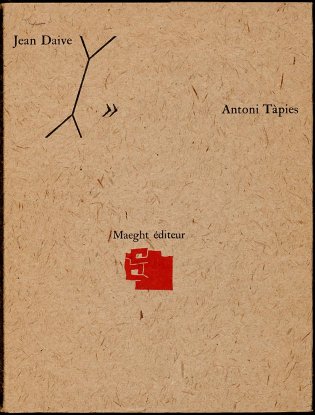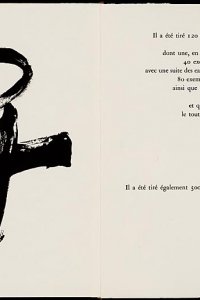Jean Daive, Antoni Tàpies
Year: 1975
Author: Jean Daive (*1941)
Artist: Antoni Tàpies (1923 - 2012)
Publisher: Maeght éditeur
Signs and symbols of Antoni Tàpies
Apparently, because Tàpies adds his own fingerprint, as if he were a bit of a father ('un peu de père »'). He too breaks with traditions. He paints numbers, letters, signs and symbols as if they were (and in stead of) figurative images. They can be individual, but they can also complete one of Daive's printed verse lines and words.
Daive published his first poems in 1967, in the magazine L'Éphémère which had been established three years earlier by the publisher and maecenas Aimé Maeght together with Du Bouchet and Bonnefoy. The word 'Éphémère' indicates the fleeting, the transitory, but it also means 'neutral value'. The magazine does not contain standard criticism or analyses. It contrasts old and new poetry with works of art. In this way, text and image can speak for themselves and for each other.
Description bibliographiques
Description: Jean Daive, Antoni Tàpies / [texte] Jean Daive ; [ill.] Antoni Tàpies. - Paris : Maeght éditeur, 1975. - [80] p. ; 25 cm
Printer: Adrien Maeght (Paris)
Edition: 620 copies
This copy: Number 180 of 500 on vélin chiffon
Typeface: Caslon
Bibliography: Bénézit 13-465 ; In liefde verzameld-49; Johnson 30-508; Monod 3362
Shelfmark: KW KOOPM B 1084
References
- Jan K. Birksted, Modernism and the Mediterranean: The Maeght Foundation. Aldershot, Ashgate, 2004
- Jean-Marie Gleize, 'Daive, Jean' in: Dictionnaire de poésie de Baudelaire à nos jours. Paris, Presses universitaires de France, 2001, p. 176
- Jean-Louis Prat, L’univers d’Aimé et Marguerite Maeght. Saint-Paul, Fondation Maeght, 1982
- De l'écriture à la peinture. Saint-Paul, Fondation Maeght, 2004


![Jean Daive, Antoni Tàpies(1975), p. [40]-[41]](/sites/default/files/styles/galerie/public/images/jean-daive-antoni-tapies-p40-41.jpg?h=d762a811&itok=3TyZj_oI)
